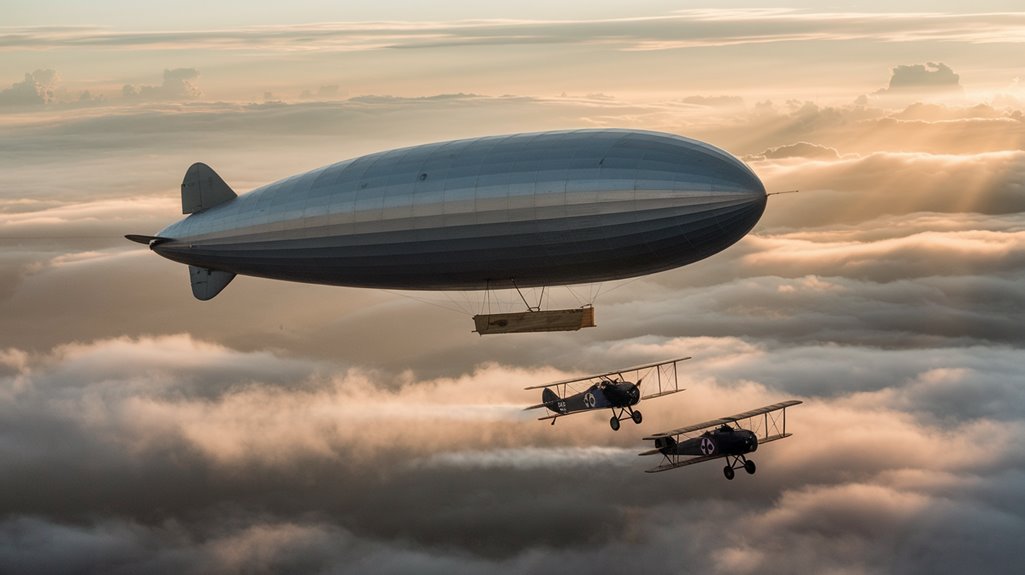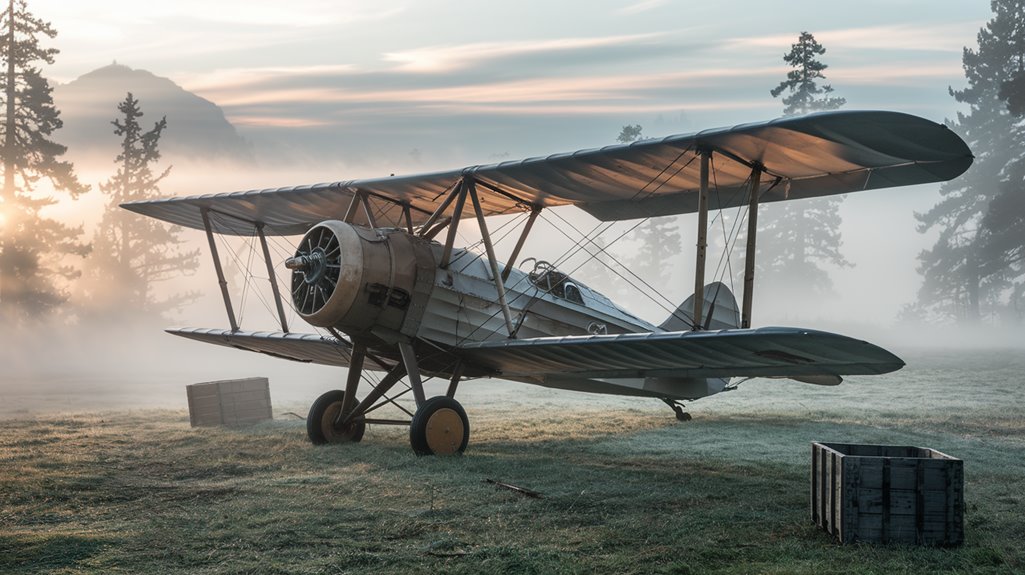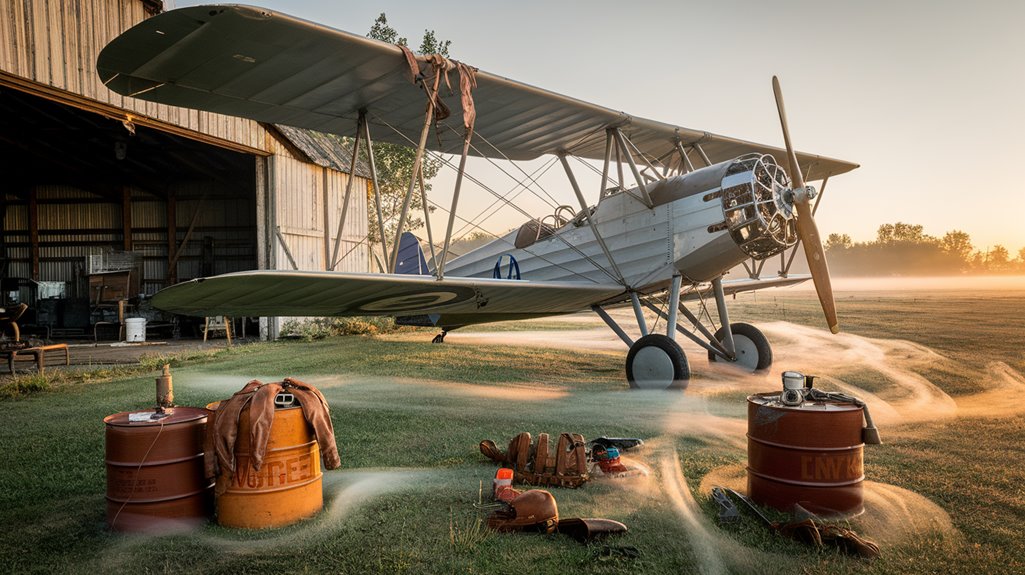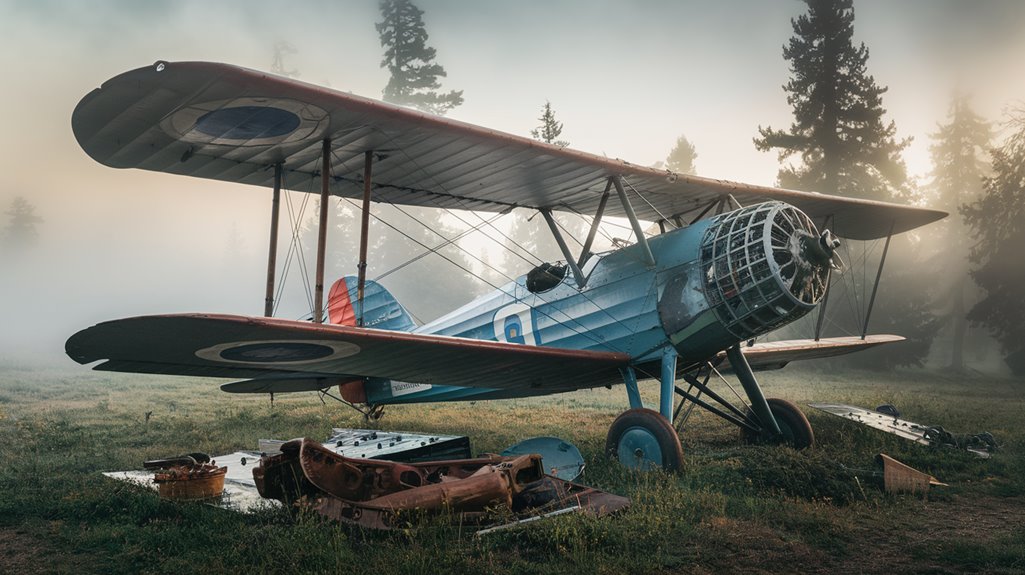Sky Pirates? The Real-Life Bandits of Early Aviation
Did you know that by 1930, commercial airlines were losing an estimated $100,000 annually to airborne theft? You've probably heard tales of swashbuckling pirates on the high seas, but the skies held their own breed of bandits. As aviation took off in the early 20th century, so did a new form of crime that would change transportation forever. From armed revolutionaries to cunning con artists, these aerial outlaws wrote a darker chapter in aviation's golden age that you won't find in most history books.
The Rise of Zeppelins in World War I

While airships had existed before World War I, the German military transformed Zeppelins into formidable weapons of war starting in 1914. You can trace their origins to 1900, when Graf Ferdinand von Zeppelin launched his first successful airship, revolutionizing Zeppelin technology.
These massive vessels changed warfare forever by introducing systematic strategic bombing across the English Channel. You'd find them conducting reconnaissance missions, photographing critical targets, and penetrating deep into enemy territory. A typical Zeppelin could carry up to 1,800 kg of bombs while being powered by multiple motors. Early raids revealed their weakness when the Germans had to drop artillery shells due to a lack of proper bombing equipment.
However, their success came at a steep price. When flying at low altitudes, they proved extremely vulnerable to ground fire, and technical challenges made them dangerous to operate in harsh weather. Despite these limitations, they helped establish the foundations of air power, even though 66% of German Zeppelins were eventually shot down or disabled.
The Legendary L.23 Zeppelin Incident
Among World War I's most remarkable naval encounters, the capture of the Norwegian schooner *Royal* by German Zeppelin L 23 stands as the only successful airship-to-ship seizure in history.
You'd find it hard to believe, but this daring maritime capture took place off the Danish coast in April 1917, when the L 23 spotted the schooner carrying contraband pit-props.
The gaff-rigged vessel displaced 688 tons and showcased the classic beauty of traditional sailing ships.
The zeppelin tactics were unprecedented: after the Royal's crew abandoned ship, the L 23 executed a water landing, dispatching three armed men to board the vessel.
While the German High Command later discouraged such risky maneuvers, this bold operation succeeded.
Under the command of Captain Ludwig Bold, the entire operation lasted an impressive 43 hours until German destroyers arrived.
The captured schooner was escorted to Cuxhaven by German destroyers, where the crew faced martial law.
This legendary incident boosted Airship Service morale and remains a unique chapter in aviation history.
Traditional Pirates vs. Sky Raiders
Despite their shared title of "pirates," traditional maritime raiders and aerial marauders operated in vastly different worlds.
While sea pirates relied on pirate tactics like fast boats and motherships to intercept cargo vessels, sky raiders employed unique aerial tactics with their specialized aircraft.
In 1917, the German zeppelin L.23 made history when its crew became the first and only bona fide sky pirates in a daring boarding action.
Modern pirates have evolved into profit-driven criminals who target commercial vessels carrying valuable cargo.
You'll find four key differences between these groups:
- Operating environment: Sea pirates navigate water routes, while sky raiders battled weather conditions.
- Technology: Maritime pirates use radar and boats, while aerial raiders relied on zeppelins and aircraft.
- Operational lifespan: Traditional pirates continue to evolve, while sky pirates had a brief historical window.
- Support systems: Sea pirates utilize motherships for extended raids, while aerial raiders needed specialized ground facilities.
Today's maritime pirates continue to adapt with modern technology, while sky raiders remain a fascinating chapter in aviation history.
The Flying Bandit's Aerial Heists
The early 1930s marked a turning point when air piracy shifted from theoretical threat to stark reality.
You'll find the first confirmed case in Peru, where Byron Richards faced armed revolutionaries demanding a flight to Lima. Their aerial tactics were straightforward but effective: threaten the pilot and seize control of the aircraft. These pirates often organized operations from airborne carriers that served as mobile bases.
Hijacker motivations varied widely in these pioneering cases. While some sought political leverage, like Saturnino Cedillo's 1929 postal route diversion, others had more violent intentions. The commercial flight hijacking of Cathay Pacific's Miss Macao in 1948 demonstrated how these crimes were evolving beyond military targets.
The 1932 Brazilian incident showed how dangerous inexperienced hijackers could be when three men commandeered a Sikorsky S-38, leading to a fatal crash.
These early heists established patterns you'd see repeated for decades: the use of weapons, threats, and deception to gain control of aircraft and fulfill various criminal or political objectives.
Historical Impact and Legacy of Sky Piracy

While early aviation faced numerous challenges, sky piracy's emergence fundamentally shaped modern air travel security. Just as public hangings were used to deter maritime piracy, severe punishments became standard for aerial crimes. You'll find that international law evolved rapidly to address this threat, leading to groundbreaking agreements like the Tokyo and Hague Conventions. The devastating September 11 attacks demonstrated how aerial threats could transform into weapons of mass destruction.
The legacy of sky piracy continues to influence how you fly today through:
- Mandatory screening procedures established by aviation security agencies
- Global cooperation in tracking and preventing aerial crimes
- Strengthened cockpit security measures and crew protocols
- Enhanced passenger identification requirements
These developments weren't merely reactive measures; they represented a complete transformation in how we approach air travel safety.
The single documented case of the *Royal* zeppelin incident in 1917 may seem isolated, but it catalyzed decades of security innovations that protect millions of passengers today.
Myths and Realities of Airborne Crime
Popular media has romanticized sky pirates as swashbuckling adventurers in flying vessels, yet reality tells a starkly different story. Instead of mythical hijackings featuring dashing rogues, you'll find that most airborne crimes involve political motives, ransom demands, or military conflicts.
Real cases paint a sobering picture of airborne terrorism and forced landings. Consider the 2021 Ryanair incident, where Belarus forced a commercial flight to land, or the 1995 Airstan incident involving Taliban fighters. During World War II, unrestricted submarine warfare demonstrated how military forces could disregard international laws governing transportation and commerce. During the Philippine-American War, U.S. forces employed aerial interrogation tactics including torture methods against captured enemies.











